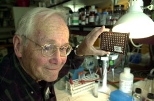A group of existing compounds with known biological properties--some of which are already FDA-approved for various uses--may turn out to reverse the effects of early- to mid-stage Alzheimer's disease, MIT researchers reported recently in Biochemical and Biophysical Research Communications.
Vernon M. Ingram, the John and Dorothy Wilson Professor of Biology, and colleagues screened more than 1,500 compounds. They found that in cell cultures, 10 of them reversed a process caused by the beta-amyloid plaques that attack the brains of Alzheimer's patients.
These "hit compounds have only been tested on nerve cell cultures grown in a laboratory. But as potential future drugs, they show promise for the restoration of cognitive function in the treatment of early and mid-stage Alzheimer's disease," the authors wrote.
"We need a third leg to the stool. This is a totally different approach that will not take the place of existing efforts, but may supplement them," Ingram said. "AIDS treatment consists of a cocktail of medications. It may be the same with Alzheimer's. We may need more than one drug working together."
A SEARCH FOR DRUGS
Ingram and co-authors Barbara J. Blanchard, senior technical associate in the Department of Biology, and Veena Thomas, a biology major who graduated from MIT last week, found a molecular mechanism that explains how toxic beta-amyloid peptides attack brain cells.
In one of two papers published simultaneously, the researchers describe molecular changes that occur in the cell when the clumped peptide--the plaque found in the brains of Alzheimer's patients--interacts with receiving proteins on the cell's surface. They believe that the effects they see in the cell culture also occur in the brains of Alzheimers' victims, leading to symptoms such as memory loss and disorientation.
In the second of the two papers, coauthored with Brent R. Stockwell, a fellow of the Whitehead Institute for Biomedical Research, the researchers screened a library of some 1,500 compounds to discover drugs that might counter the plaques' negative effects. The screen resulted in 10 compounds that were able to reduce or eliminate the effect described in the first paper. Some of these are drugs approved by the U.S. Food and Drug Administration for conditions unrelated to Alzheimer's disease, including cancer.
So far, these drugs have been tested only on nerve cells. The next steps are to try them on normal mice for possible toxic side effects, and on mice genetically engineered to develop the memory deficits characteristic of Alzheimer's disease, Ingram said.
Alzheimer's disease involves the dysfunction and eventual death of certain types of nerve cells. Symptoms are thought to be caused by abnormally high concentrations of beta-amyloid peptides in the brain.
Beta-amyloid peptides, which form clumps or plaques, are the by-products of a normal protein that has been abnormally processed.
Electrical impulses underlie cell-to-cell communication and are the basis of any cognitive function in the brain. "When a clumped amyloid peptide is present, those brain cells, we believe, become hypersensitive and respond inappropriately to signals from other cells," Ingram said. "This could cause interference in memory formation, memory recall and a million other signals."
HITTING A BULL'S-EYE
In addition to leading to potential Alzheimer's treatments, this work uncovers new information about how cells work at the molecular level.
"Finding so many 'hit compounds' gives exciting insights into the cellular mechanisms for maintaining and modulating the all-important membrane potential of neuronal cells," Ingram said. "The biochemical functions of the hit compounds are known, so they illustrate the molecular events that occur inside a nerve cell attacked by a neurotoxic peptide.
"Some of these molecular events were quite unexpected, but they define the sequence of biochemical events. This illustration of molecular mechanisms inside the cell is an unexpected bonus," he said.
This work is funded by the John and Dorothy Wilson Fund and the Kurt and Johanna Immerwahr Fund for Alzheimer Research at MIT.
A version of this article appeared in MIT Tech Talk on June 12, 2002.







